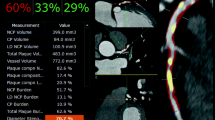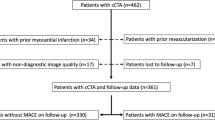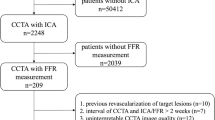Abstract
Objectives
We aimed to investigate if lesion-specific ischaemia by invasive fractional flow reserve (FFR) can be predicted by an integrated machine learning (ML) ischaemia risk score from quantitative plaque measures from coronary computed tomography angiography (CTA).
Methods
In a multicentre trial of 254 patients, CTA and invasive coronary angiography were performed, with FFR in 484 vessels. CTA data sets were analysed by semi-automated software to quantify stenosis and non-calcified (NCP), low-density NCP (LD-NCP, < 30 HU), calcified and total plaque volumes, contrast density difference (CDD, maximum difference in luminal attenuation per unit area) and plaque length. ML integration included automated feature selection and model building from quantitative CTA with a boosted ensemble algorithm, and tenfold stratified cross-validation.
Results
Eighty patients had ischaemia by FFR (FFR ≤ 0.80) in 100 vessels. Information gain for predicting ischaemia was highest for CDD (0.172), followed by LD-NCP (0.125), NCP (0.097), and total plaque volumes (0.092). ML exhibited higher area-under-the-curve (0.84) than individual CTA measures, including stenosis (0.76), LD-NCP volume (0.77), total plaque volume (0.74) and pre-test likelihood of coronary artery disease (CAD) (0.63); p < 0.006.
Conclusions
Integrated ML ischaemia risk score improved the prediction of lesion-specific ischaemia by invasive FFR, over stenosis, plaque measures and pre-test likelihood of CAD.
Key Points
• Integrated ischaemia risk score improved prediction of ischaemia over quantitative plaque measures
• Integrated ischaemia risk score showed higher prediction of ischaemia than standard approach
• Contrast density difference had the highest information gain to identify lesion-specific ischaemia





Similar content being viewed by others
Abbreviations
- CDD:
-
Contrast density difference
- CP:
-
Calcified plaque
- CTA:
-
CT angiography
- DLP:
-
Dose–length product
- FFR:
-
Fractional flow reserve
- HU:
-
Hounsfield unit
- LD-NCP:
-
Low-density noncalcified plaque
- NCP:
-
Noncalcified plaque
References
Budoff MJ, Dowe D, Jollis JG et al (2008) Diagnostic performance of 64-multidetector row coronary computed tomographic angiography for evaluation of coronary artery stenosis in individuals without known coronary artery disease: results from the prospective multicenter ACCURACY (Assessment by Coronary Computed Tomographic Angiography of Individuals Undergoing Invasive Coronary Angiography) trial. J Am Coll Cardiol 52:1724–1732
Hausleiter J, Meyer T, Hadamitzky M et al (2007) Non-invasive coronary computed tomographic angiography for patients with suspected coronary artery disease: the Coronary Angiography by Computed Tomography with the Use of a Submillimeter resolution (CACTUS) trial. Eur Heart J 28:3034–3041
Achenbach S, Ropers U, Kuettner A et al (2008) Randomized comparison of 64-slice single- and dual-source computed tomography coronary angiography for the detection of coronary artery disease. J Am Coll Cardiol Cardiovascular Imaging 1:177–186
Miller JM, Rochitte CE, Dewey M et al (2008) Diagnostic performance of coronary angiography by 64-row CT. N Engl J Med 359:2324–2336
Meijboom WB, van Mieghem CAG, Mollet NR et al (2007) 64-slice computed tomography coronary angiography in patients with high, intermediate, or low pretest probability of significant coronary artery disease. J Am Coll Cardiol 50:1469–1475
Achenbach S, Moselewski F, Ropers D et al (2004) Detection of calcified and noncalcified coronary atherosclerotic plaque by contrast-enhanced, submillimeter multidetector spiral computed tomography: a segment-based comparison with intravascular ultrasound. Circulation 109:14–17
Achenbach S, Ropers D, Hoffmann U et al (2004) Assessment of coronary remodeling in stenotic and nonstenotic coronary atherosclerotic lesions by multidetector spiral computed tomography. J Am Coll Cardiol 43:842–847
Leber AW, Becker A, Knez A et al (2006) Accuracy of 64-slice computed tomography to classify and quantify plaque volumes in the proximal coronary system: a comparative study using intravascular ultrasound. J Am Coll Cardiol 47:672–677
Leber AW, Knez A, Becker A et al (2004) Accuracy of multidetector spiral computed tomography in identifying and differentiating the composition of coronary atherosclerotic plaques: a comparative study with intracoronary ultrasound. J Am Coll Cardiol 43:1241–1247
Pundziute G, Schuijf JD, Jukema JW et al (2008) Evaluation of plaque characteristics in acute coronary syndromes: non-invasive assessment with multi-slice computed tomography and invasive evaluation with intravascular ultrasound radiofrequency data analysis. Eur Heart J 29:2373–2381
Tonino PA, De Bruyne B, Pijls NH et al (2009) Fractional flow reserve versus angiography for guiding percutaneous coronary intervention. N Engl J Med 360:213–224
Pijls NH, Fearon WF, Tonino PA et al (2010) Fractional flow reserve versus angiography for guiding percutaneous coronary intervention in patients with multivessel coronary artery disease: 2-year follow-up of the FAME (Fractional Flow Reserve Versus Angiography for Multivessel Evaluation) study. J Am Coll Cardiol 56:177–184
Park HB, Heo R, Ó Hartaigh B et al (2015) Atherosclerotic plaque characteristics by CT angiography identify coronary lesions that cause ischemia: a direct comparison to fractional flow reserve. JACC Cardiovasc Imaging 8:1–10
Gaur S, Øvrehus KA, Dey D et al (2016) Coronary plaque quantification and fractional flow reserve by coronary computed tomography angiography identify ischaemia-causing lesions. Eur Heart J. https://doi.org/10.1093/eurheartj/ehv690
Deo RC (2015) Machine learning in medicine. Circulation 132:1920–1930
Waljee AK, Higgins PD (2010) Machine learning in medicine: a primer for physicians. Am J Gastroenterol 105:1224–1226
Arsanjani R, Xu Y, Dey D et al (2013) Improved accuracy of myocardial perfusion SPECT for detection of coronary artery disease by machine learning in a large population. J Nucl Cardiol 20:553–562
Kang D, Slomka PJ, Nakazato R et al (2013) Automated knowledge-based detection of nonobstructive and obstructive arterial lesions from coronary CT angiography. Med Phys 40:041912
Motwani M, Dey D, Berman DS et al (2017) Machine learning for prediction of all-cause mortality in patients with suspected coronary artery disease: a 5-year multicentre prospective registry analysis. Eur Heart J 38:500–507
Ambale-Venkatesh B, Yang X, Wu CO et al (2017) Cardiovascular event prediction by machine learning: the multi-ethnic study of atherosclerosis. Circ Res 9:311312
Norgaard BL, Leipsic J, Gaur S et al (2014) Diagnostic performance of noninvasive fractional flow reserve derived from coronary computed tomography angiography in suspected coronary artery disease: the NXT trial (Analysis of Coronary Blood Flow Using CT Angiography: Next Steps). J Am Coll Cardiol 63:1145–1155
Montalescot G, Sechtem U, Achenbach S et al (2013) 2013 ESC guidelines on the management of stable coronary artery disease: the Task Force on the management of stable coronary artery disease of the European Society of Cardiology. Eur Heart J 34:2949–3003
Leipsic J, Abbara S, Achenbach S et al (2014) SCCT guidelines for the interpretation and reporting of coronary CT angiography: a report of the Society of Cardiovascular Computed Tomography Guidelines Committee. J Cardiovasc Comput Tomogr 8:342–358
Dey D, Cheng VY, Slomka PJ et al (2009) Automated three-dimensional quantification of non-calcified and calcified coronary plaque from coronary CT angiography. J Cardiovasc Comput Tomogr 3:372–382
Dey D, Schepis T, Marwan M, Slomka PJ, Berman DS, Achenbach S (2010) Automated three-dimensional quantification of non-calcified coronary plaque from coronary CT angiography: comparison with intravascular ultrasound. Radiology 257:516–522
Motoyama S, Sarai M, Harigaya H et al (2009) Computed tomographic angiography characteristics of atherosclerotic plaques subsequently resulting in acute coronary syndrome. J Am Coll Cardiol 54:49–57
Hell MM, Dey D, Marwan M, Achenbach S, Schmid J, Schuhbaeck A (2015) Non-invasive prediction of hemodynamically significant coronary artery stenoses by contrast density difference in coronary CT angiography. Eur J Radiol 84:1502–1508
Schuhbaeck A, Dey D, Otaki Y et al (2013) Interscan reproducibility of quantitative coronary plaque volume and composition from CT coronary angiography using an automated method. J Am Coll Cardiol. https://doi.org/10.1016/S0735-1097(1013)61040-61042
Hall M, Frank E, Holmes G, Pfahringer B, Reutemann P, Witten IH (2009) The WEKA data mining software: an update. SIGKDD Explor Newsl 11:10–18
Arsanjani R, Dey D, Khachatryan T et al (2015) Prediction of revascularization after myocardial perfusion SPECT by machine learning in a large population. J Nucl Cardiol 22:877–884
Hall MA, Holmes G (2003) Benchmarking attribute selection techniques for discrete class data mining. IEEE Trans Knowl Data Eng 15:1437–1447
Fayyad UM, Irani KB (1993) Multi-interval discretization of continuous valued attributes for classification learning. Thirteenth International Joint Conference on Artificial Intelligence, 1022-1027
Friedman J, Hastie T, Tibshirani R (2000) Additive logistic regression: a statistical view of boosting. Ann Stat 28:337–407
Witten IH, Frank E, Hall MA (2011) Data mining: practical machine learning tools and techniques, 3rd edn. Morgan Kaufmann, Burlington
Molinaro AM, Simon R, Pfeiffer RM (2005) Prediction error estimation: a comparison of resampling methods. Bioinformatics 21:3301–3307
DeLong ER, DeLong DM, Clarke-Pearson DL (2007) Comparing the areas under two or more correlated receiver operating characteristic curves: a nonparametric approach. Biometrics 44:837–845
Pencina MJ, D'Agostino RB, Pencina KM, Janssens ACJW, Greenland P (2012) Interpreting incremental value of markers added to risk prediction models. Am J Epidemiol 176:473–481
Park H-B, Heo R, ó Hartaigh B et al (2015) Atherosclerotic plaque characteristics by CT angiography identify coronary lesions that cause ischemia: a direct comparison to fractional flow reserve. JACC Cardiovasc Imaging 8:1–10
Diaz Zamudio M, Dey D, Schuhbaeck A et al (2015) Automated quantitative plaque burden from coronary CT angiography noninvasively predicts hemodynamic significance by fractional flow reserve in intermediate coronary lesions. Radiology 276:408–415
Ko BS, Wong DT, Cameron JD et al (2015) The ASLA score: a CT angiographic index to predict functionally significant coronary stenoses in lesions with intermediate severity-diagnostic accuracy. Radiology 276:91–101
Min JK, Leipsic J, Pencina MJ et al (2012) Diagnostic accuracy of fractional flow reserve from anatomic CT angiography. JAMA 308:1237–1245
Koo BK, Erglis A, Doh JH et al (2011) Diagnosis of ischemia-causing coronary stenoses by noninvasive fractional flow reserve computed from coronary computed tomographic angiograms. Results from the prospective multicenter DISCOVER-FLOW (Diagnosis of Ischemia-Causing Stenoses Obtained Via Noninvasive Fractional Flow Reserve) study. J Am Coll Cardiol 58:1989–1997
Coenen A, Lubbers MM, Kurata A et al (2015) Fractional flow reserve computed from noninvasive CT angiography data: diagnostic performance of an on-site clinician-operated computational fluid dynamics algorithm. Radiology 274:674–683
Itu L, Rapaka S, Passerini T et al (2016) A machine-learning approach for computation of fractional flow reserve from coronary computed tomography. J Appl Physiol (1985) 121:42–52
Ko BS, Cameron JD, Leung M et al (2012) Combined CT coronary angiography and stress myocardial perfusion imaging for hemodynamically significant stenoses in patients with suspected coronary artery disease: a comparison with fractional flow reserve. JACC Cardiovasc Imaging 5:1097–1111
Obermeyer Z, Emanuel EJ (2016) Predicting the future - big data, machine learning, and clinical medicine. N Engl J Med 375:1216–1219
Funding
This study has received funding by National Heart Lung Blood Institute (NIH/NHLBI grant R01HL133616) and the Bundesministerium für Bildung und Forschung (01EX1012B, Spitzencluster Medical Valley)
Author information
Authors and Affiliations
Corresponding author
Ethics declarations
Guarantor
The scientific guarantor of this publication is Dr. Damini Dey (Associate Professor, Cedars-Sinai Medical Center).
Conflict of interest
The authors of this manuscript declare relationships with the following companies: None.
Dr. Piotr Slomka, Dr. Daniel S Berman and Dr. Damini Dey received software royalties from Cedars-Sinai Medical Center and hold a patent.
Statistics and biometry
One of the co-authors (Heidi Gransar, MS) is an experienced biostatistician and she provided her expertise for this study.
Informed consent
Written informed consent was obtained from all subjects (patients) in this study.
Ethical approval
Institutional review board approval was obtained.
Study subjects or cohorts overlap
This study is a new post hoc analysis comprising all 254 patients from the prospective, multicentre NXT trial (NCT01757678). The original study has been previously described (Norgaard et al. J Am Coll Cardiology 2014 [21]). While the patient cohort is the same, there was no overlap with this study which evaluates objective machine learning integration of quantitative coronary CT angiography to predict ischaemia.
Methodology
• prospective study
• post hoc analysis
• multicentre study
Rights and permissions
About this article
Cite this article
Dey, D., Gaur, S., Ovrehus, K.A. et al. Integrated prediction of lesion-specific ischaemia from quantitative coronary CT angiography using machine learning: a multicentre study. Eur Radiol 28, 2655–2664 (2018). https://doi.org/10.1007/s00330-017-5223-z
Received:
Revised:
Accepted:
Published:
Issue Date:
DOI: https://doi.org/10.1007/s00330-017-5223-z




